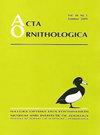Replacement Broods in a Cavity Nesting Bird Species under High Predation Pressure in Primeval Forest
IF 1.3
4区 生物学
Q3 ORNITHOLOGY
引用次数: 0
Abstract
Abstract. Predation is one of the most important factors influencing breeding success. Many bird species suffer from high losses because of predators. I studied breeding success and replacement broods in the Red-breasted Flycatcher Ficedula parva. The Red-breasted Flycatcher is a small bird breeding in natural holes in dense deciduous and mixed forests of Europe. Data were collected during twelve breeding seasons in a primeval forest, in the Bialowieża National Park, Northeast Poland, the best preserved and protected area of the Białowieża Forest with a rich community of birds and mammals including predators. Almost half of the broods of the Red-breasted Flycatcher were lost and most of them because of predation. In cases where the brood was lost in the period of egg laying or incubation, females tended to lay a replacement clutch. First and replacement nest-sites differed insignificantly in characteristics, but new clutches were always laid in a new site. Out of 68 broods, in which a loss was found, replacement broods were recorded in 47.1% cases. Replacement clutches were much smaller and pairs raised significantly fewer fledglings. The proportions of successful and lost broods were similar in the first and replacement attempts (56.1%, and 46.7%, respectively). Red-breasted Flycatchers choose shallow nest-sites that allow the females to observe their surroundings. This allows the female to escape from the nest when a predator approaches, increasing the possibility of a repeat clutch and the attainment of breeding success in the same season.原始森林中高捕食压力下腔巢鸟类的替代繁殖
摘要捕食是影响繁殖成功的最重要因素之一。由于捕食者的存在,许多鸟类遭受了巨大的损失。我研究了红胸捕蝇蝇的繁殖成功率和替代产卵。红胸捕蝇鸟是一种小型鸟类,在欧洲茂密的落叶和混交林的天然洞穴中繁殖。数据是在波兰东北部Bialowieża国家公园的一个原始森林的12个繁殖季节收集的,该森林是Białowieża森林中保存最完好的保护区,拥有丰富的鸟类和哺乳动物群落,包括食肉动物。几乎有一半的红胸捕蝇鸟的后代消失了,其中大部分是因为被捕食。如果在产卵或孵化期间失去了一窝卵,雌性往往会产下一窝替代的卵。第一巢和替代巢在特征上差异不显著,但新窝总是在新巢中产卵。在发现的68个雏鸟损失中,有47.1%的雏鸟被替换。替换的离合器要小得多,成对的雏鸟数量也明显减少。在第一次和替换尝试中,成功和失败的雏鸟比例相似(分别为56.1%和46.7%)。红胸捕蝇鸟选择较浅的筑巢地点,这样雌性可以观察周围的环境。这使得雌性可以在捕食者接近时逃离巢穴,增加了重复产卵的可能性,并在同一季节成功繁殖。
本文章由计算机程序翻译,如有差异,请以英文原文为准。
求助全文
约1分钟内获得全文
求助全文
来源期刊

Acta Ornithologica
生物-鸟类学
CiteScore
2.10
自引率
0.00%
发文量
14
审稿时长
>12 weeks
期刊介绍:
Publishes scientific papers (original research reports, reviews, short notes, etc.) and announcements from all fields of ornithology. All manuscripts are peer-reviewed.
Established in 1933 as Acta Ornithologica Musei Zoologici Polonici, since 1953 continued under the present title.
Published twice a year by the Natura Optima Dux Foundation under the auspices of the Museum and Institute of Zoology, Polish Academy of Sciences.
 求助内容:
求助内容: 应助结果提醒方式:
应助结果提醒方式:


